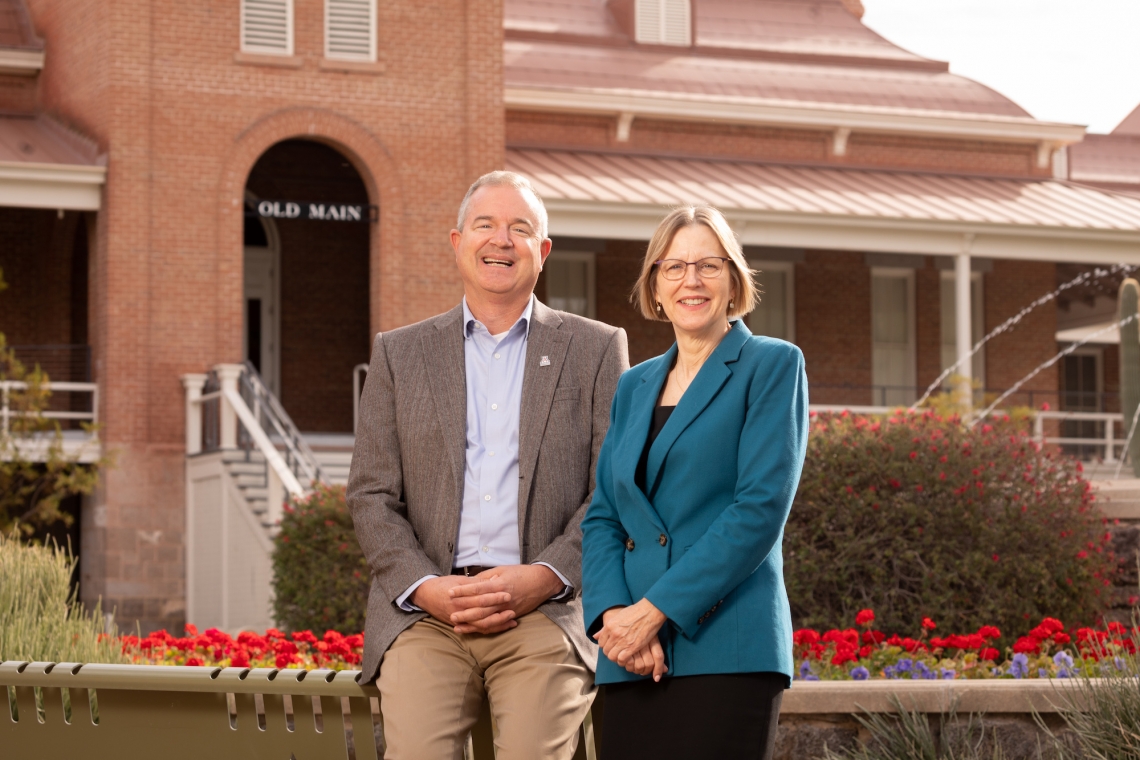[ad_1]
by Katy Smith, College of Engineering
today

David W. Hahn, Craig M. Burge Dean of the College of Engineering, and Joan Swesey, Nancy C. and Craig M. Burge Endowed Chair for the University of Arizona Cancer Center Director
Chris Richards / University of Arizona
Eradicating cancer is a complex goal because of the environment in which the disease thrives – the human body.
“We’ve treated cancer in petri dishes, and we’ve treated cancer in mice. We haven’t treated cancer in people, because people are none of those things,” said the University of Arizona researcher. jennifer bartonThomas R. Brown Distinguished Chair in Biomedical Engineering and University Director BIO5 Institute,
Barton is part of the University of Arizona Cancer Engineering Initiative, which was awarded $10.8 million over three years through the state of Arizona. new economy initiativeBeginning of the financial year 2022-2023.
effort started from David W Hahn, Craig M. Burge Dean College of EngineeringAnd Joan SweseyThe Nancy C. and Craig M. Burge Endowed Chair for the Director of University of Arizona Cancer Center, They formed a working group around a shared vision: merge engineering and cancer research to better account for the realities of how and where cancer grows in order to improve diagnosis, prevention and precision treatments for cancer.
Work includes identifying how cancer cells respond to imaging methods, drugs, blood flow conditions and mechanical stresses in different environments that mimic human tissues. 3D printing is critical for generating tissue models that allow the study of cancer initiation, development, metastasis and response to therapies.
“Eradicating cancer is one of the greatest challenges in medicine,” said the University of Arizona president. Robert C Robbins, who is also a medical doctor. “Thanks to the support of Arizona’s New Economy Initiative, this exciting collaboration provides the health and engineering expertise of the University of Arizona with innovative tools that will provide new answers and a better understanding of cancer and its treatments.”
Cancer engineering: ‘pushing the limits’
Many of the standard cancer treatments currently in use are not tailored for specific patients and sometimes not for the exact type of cancer.
“These treatments often do a good job of killing a select population of cancer cells that are sensitive to the treatment,” said Arthur Gimitro, professor and head of Department of Biomedical Engineering and member of the initiative’s working group. “But, often, there are cancer cells remaining that have evolved to be less sensitive to that kind of treatment.”
With 3D-printed growth environments, which are called biomimetic because they mimic human tissue, engineers can help develop precise treatments. Gmitro said researchers can place cancer cells from a patient in these environments to test the efficacy of treatments specific to those cells, which could lead to the development of precise treatment strategies.
Engineers can also create 3D models of the cancer itself, speeding up understanding of methods for diagnosis and prevention. Knowledge acquisition in one area feeds other areas.
“You have cancer biology, detection and treatment, and those three things can’t be approached separately,” Barton said. “To detect something, you need to know what the signal is. And then you have to understand cancer biology and the signals to treat it effectively. You need to incorporate all of that into a cancer engineering program “
Advances in polymer development and 3D printing technology over the past decade have made cancer research collaboration a promising engineering focus area. Additionally, Hahn said, the mechanics of tumors and their environments fall into the realm of engineering science. However, cancer engineering is a new field of study with much untapped potential.
“We’re pushing the boundaries of what’s happening. There’s some activity going on around the country, but this is new,” Hahn said.
support against cancer
The uArizona Cancer Center recently named cancer engineering as one of its top three disciplines as part of the strategic planning process when renewing its designation as one. Comprehensive Cancer Center from the National Cancer Institute,
Hahn said the effort is uniquely aligned with the New Economy Initiative, which focuses on specific opportunities.
“If we make it to the heights of success, companies will manufacture and license the technology from the University of Arizona,” he said. “They’ll start to grow until we have a center of gravity in Arizona that will create thousands of jobs and change lives. That’s the dream of the New Economy Initiative and what we work for every day.”
The cancer center is one of 16 centers in the University of Arizona Health Sciences that advocated for funding to strengthen the collaboration.
University of Arizona Senior Vice President of Health Sciences Dr. Michael D. deck, “The partnership between the Cancer Center and the College of Engineering is critical to the investigation and solution of our most pressing health care problems, including cancer.”
The initiative, Barton said, will go beyond engineering and health science, requiring expertise in data analysis, health law, regulatory affairs, physician practices and patient understanding.
“It’s such a complex problem that we have to bring people together – and frankly, that’s why the University of Arizona is such a great place to do that,” she said. “We have expertise in biomechanics, tissue engineering and imaging, and we have 3D cell printers and a drug discovery group. Our centers are used to working with each other.”
Barton and his colleagues at the Arizona Cancer Center and College of Engineering plan to hire three to five additional researchers to focus on the initiative.
The project will also involve students from all levels and multiple disciplines in cancer research. Swesey said the ongoing investigation is likely to attract medical students who contribute innovative thinking.
“They are attracted to collaborative and team science ventures, which is important because when you get a lot of smart people in a room, especially students, a project can really take off and go somewhere,” she said. Told.
[ad_2]
Source link

